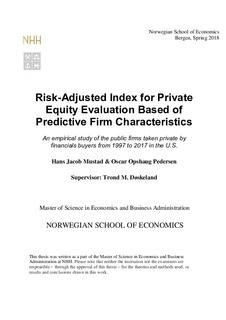Risk-adjusted index for private equity evaluation based of predictive firm characteristics : An empirical study of the public firms taken private by financials buyers from 1997 to 2017 in the U.S.
Master thesis
Permanent lenke
http://hdl.handle.net/11250/2559883Utgivelsesdato
2018Metadata
Vis full innførselSamlinger
- Master Thesis [4372]
Sammendrag
The objective of this thesis is to assess if there is a risk-adjusted index which could give a
better understanding of the opportunity cost for private equity investments. Private equity has
become a more professional asset class with heightened attention from long-term investors.
The Norwegian Government Pension Fund Global recently assessed the opportunity of
moving into unlisted equity, although the proposal was rejected by The Ministry of Finance.
Despite the increased attraction to the asset class, there is a persistent lack of consensus on the
factors that explain the performance in private equity. In this thesis, we use a predictive model
to analyse the pre-transaction financial characteristics of 355 public companies taken private
by a PE sponsor. The public-to-private sample is compared to the investable indexes S&P 500,
S&P 400 and S&P 600. The indexes function as a market proxies representing distinct market
cap segments. The bottom-up analysis seeks to identify if PE funds select targets based on
certain characteristics, diverging from the market proxy, which lead to a different exposure to
systematic risk factors. We find that PE funds tend to select small profitable firms with
conservative capital structures. The findings are seen with regards to the empirical evidence
of the level of leverage in buyouts. The implication being that an appropriate investable and
risk-adjusted index seem to be a moderately leveraged S&P 600 index.
